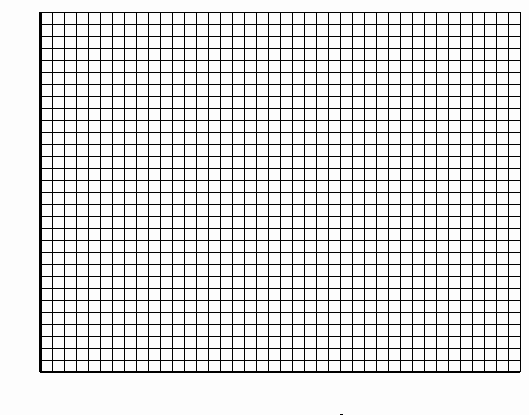

Beginner's
Guide to Propulsion
Charles and Gay-Lussac's
Law
Activity
Beginner's
Guide to Propulsion
Charles and Gay-Lussac's
Law
Activity
Before you begin:
Open The Beginners Guide to Propulsion and click on the Propulsion Index. Under Gases--Statics, open the slide titled Charles and Gay-Lussac's Law. Read the information and use it to complete the activity.
Answer the questions shown below:
- Explain what
the phrase "volume is directly proportional to the temperature" means
to you.
- If T = 1000 K
and V = 10 cu. m., what does C equal?
- Using that value
for C, find:
a. V, when T = 1,100 K
b. V, when T = 1200 K
c. V, when T = 800 K
d. V, when T = 1,400 K
- Plot these points
on a graph, or use the plot feature on a graphic calculator. Describe
the graph.

- Open the animated
version of Charles and Gay Lussac's Law slide. How does your graph
compare to the graph shown here?
- Use your graph
to find:
a. V when T = 2,000 K
b. V when T = 600 K
c. T when V = 15 cu. m.
d. T when V = 3 cu. m. - Now check your
answers for problems 3 and 6 by using the ratio V/T = C. Were they
the same? Why or why not?
- Take a look at
your answer to question 1, does your graph agree with that answer?
Why or why not?
HOME
EDUCATOR RESOURCES | AERONAUTIC EDUCATIONAL RESOURCES | INTERNET ACCESS RESEARCH | ICING RESEARCH TUNNEL
BEGINNER'S GUIDE TO AERONAUTICS | FREE SOFTWARE | AERODYNAMICS INFORMATION | AERODYNAMICS PROBLEMS | PROPULSION INFORMATION |
PROPULSION PROBLEMS | FOILSIM INFORMATION | FOILSIM PROBLEMS | ENGINESIM INFORMATION | ENGINESIM PROBLEMS | ROCKETMODELER
AERONAUTICS LESSONS & ACTIVITIES | WIND TUNNEL WEB PAGES | AERONAUTS 2000 | VIDEOCONFERENCES WITH THE U.K.
EDUCATOR RESOURCES | AERONAUTIC EDUCATIONAL RESOURCES | INTERNET ACCESS RESEARCH | ICING RESEARCH TUNNEL
BEGINNER'S GUIDE TO AERONAUTICS | FREE SOFTWARE | AERODYNAMICS INFORMATION | AERODYNAMICS PROBLEMS | PROPULSION INFORMATION |
PROPULSION PROBLEMS | FOILSIM INFORMATION | FOILSIM PROBLEMS | ENGINESIM INFORMATION | ENGINESIM PROBLEMS | ROCKETMODELER
AERONAUTICS LESSONS & ACTIVITIES | WIND TUNNEL WEB PAGES | AERONAUTS 2000 | VIDEOCONFERENCES WITH THE U.K.
Please send any comments to:
Curator: Tom.Benson@grc.nasa.gov
Responsible Official: Kathy.Zona@grc.nasa.gov
Curator: Tom.Benson@grc.nasa.gov
Responsible Official: Kathy.Zona@grc.nasa.gov